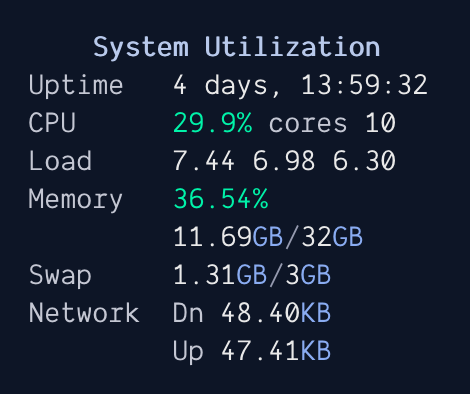Your single pane of glass for real-time analytics into MySQL/MariaDB & ProxySQL
Project description
Dolphie
Your single pane of glass for real-time analytics into MySQL/MariaDB & ProxySQL

Installation
Requires Python 3.8.1+
Using PyPi
$ pip install dolphie
Using Poetry
$ curl -sSL https://install.python-poetry.org | python3 -
$ poetry install
Using Homebrew
If you are a Homebrew user, you can install dolphie via
$ brew install dolphie
Using Docker
$ docker pull ghcr.io/charles-001/dolphie:latest
$ docker run -dit --name dolphie ghcr.io/charles-001/dolphie:latest
$ docker exec -it dolphie dolphie --tab-setup
Usage
positional arguments:
uri Use a URI string for credentials (mysql/proxysql) - format: mysql://user:password@host:port (port is optional with default 3306, or 6032 for ProxySQL)
options:
--help show this help message and exit
--tab-setup Start Dolphie by showing the Tab Setup modal instead of automatically connecting with the specified options
-C , --cred-profile Credential profile to use. See below for more information
-u , --user Username
-p , --password Password
-h , --host Hostname/IP address
-P , --port Port (socket has precedence)
-S , --socket Socket file
-c , --config-file Dolphie's config file to use. Options are read from these files in the given order: ['/etc/dolphie.cnf', '/etc/dolphie/dolphie.cnf', '~/.dolphie.cnf']
-m , --mycnf-file MySQL config file path to use. This should use [client] section [default: ~/.my.cnf]
-l , --login-path Specify login path to use with mysql_config_editor's file ~/.mylogin.cnf for encrypted login credentials [default: client]
-r , --refresh-interval
The time, in seconds, between each data collection and processing cycle [default: 1]
--host-cache-file Resolve IPs to hostnames when your DNS is unable to. Each IP/hostname pair should be on its own line using format ip=hostname [default: ~/dolphie_host_cache]
--tab-setup-file Specify location of file that stores the available hosts to use in Tab Setup modal [default: ~/dolphie_hosts]
--heartbeat-table (MySQL only) If your hosts use pt-heartbeat, specify table in format db.table to use the timestamp it has for replication lag instead of Seconds_Behind_Master from SHOW REPLICA STATUS
--ssl-mode Desired security state of the connection to the host. Supports: REQUIRED/VERIFY_CA/VERIFY_IDENTITY [default: OFF]
--ssl-ca Path to the file that contains a CA (certificate authority)
--ssl-cert Path to the file that contains a certificate
--ssl-key Path to the file that contains a private key for the certificate
--panels What panels to display on startup separated by a comma. Supports: dashboard,processlist,graphs,replication,metadata_locks,ddl,proxysql_hostgroup_summary,proxysql_mysql_query_rules,proxysql_command_stats [default: dashboard,processlist]
--graph-marker What marker to use for graphs (available options: https://tinyurl.com/dolphie-markers) [default: braille]
--pypi-repo What PyPi repository to use when checking for a new version default: [https://pypi.org/pypi/dolphie/json]
-H , --hostgroup This is used for creating tabs and connecting to them for hosts you specify in Dolphie's config file under a hostgroup section. As an example, you'll have a section called [cluster1] then below it you will list each host on a new line in the format key=host (keys have no meaning). Hosts support optional port (default is whatever port parameter is) in the format host:port. You can also name the tabs by suffixing ~tab_name to the host (i.e. 1=host~tab_name)
-R, --record Enables recording of Dolphie's data to a replay file. Note: This can use significant disk space. Monitor accordingly!
-D, --daemon Starts Dolphie in daemon mode. This will not show the TUI and is designed be put into the background with whatever solution you decide to use. Automatically enables --record. This mode is solely used for recording data to a replay file
--daemon-log-file Full path of the log file for daemon mode
--replay-file Specify the full path of the replay file to load and enable replay mode
--replay-dir Directory to store replay data files
--replay-retention-hours
Number of hours to keep replay data. Data will be purged every hour [default: 48]
--exclude-notify-vars
Dolphie will let you know when a global variable has been changed. If you have variables that change frequently and you don't want to see them, you can specify which ones with this option separated by a comma (i.e. --exclude-notify-vars=variable1,variable2)
--show-trxs-only (MySQL only) Start with only showing threads that have an active transaction
--additional-columns Start with additional columns in Processlist panel
--debug-options Display options that are set and what they're set by (command-line, dolphie config, etc) then exit. WARNING: This will show passwords and other sensitive information in plain text
-V, --version Display version and exit
Order of precedence for methods that pass options to Dolphie:
1. Command-line
2. Credential profile (set by --cred-profile)
3. Environment variables
4. Dolphie's config (set by --config-file)
5. ~/.mylogin.cnf (mysql_config_editor)
6. ~/.my.cnf (set by --mycnf-file)
Credential profiles can be defined in Dolphie's config file as a way to store credentials for easy access.
A profile can be created by adding a section in the config file with the format: [credential_profile_<name>]
When using a credential profile, do not include the prefix 'credential_profile' (i.e. -C production)
The following options are supported in credential profiles:
user
password
socket
ssl_mode REQUIRED/VERIFY_CA/VERIFY_IDENTITY
ssl_ca
ssl_cert
ssl_key
mycnf_file
login_path
MySQL my.cnf file supports these options under [client] section:
host
user
password
port
socket
ssl_mode REQUIRED/VERIFY_CA/VERIFY_IDENTITY
ssl_ca
ssl_cert
ssl_key
Login path file supports these options:
host
user
password
port
socket
Environment variables support these options:
DOLPHIE_USER
DOLPHIE_PASSWORD
DOLPHIE_HOST
DOLPHIE_PORT
DOLPHIE_SOCKET
DOLPHIE_SSL_MODE REQUIRED/VERIFY_CA/VERIFY_IDENTITY
DOLPHIE_SSL_CA
DOLPHIE_SSL_CERT
DOLPHIE_SSL_KEY
Dolphie's config supports these options under [dolphie] section:
(bool) tab_setup
(str) credential_profile
(str) user
(str) password
(str) host
(int) port
(str) socket
(str) ssl_mode
(str) ssl_ca
(str) ssl_cert
(str) ssl_key
(str) mycnf_file
(str) login_path
(str) host_cache_file
(str) tab_setup_file
(int) refresh_interval
(str) heartbeat_table
(str) startup_panels
(str) graph_marker
(str) pypi_repository
(str) hostgroup
(bool) show_trxs_only
(bool) show_additional_query_columns
(bool) record_for_replay
(bool) daemon_mode
(str) daemon_mode_log_file
(str) replay_file
(str) replay_dir
(int) replay_retention_hours
(str) exclude_notify_global_vars
Supported MySQL versions
- MySQL/Percona Server 5.6/5.7/8.x/9.x
- AWS RDS/Aurora
- Azure MySQL
Supported MariaDB versions
- MariaDB 5.5/10.0/11.0+
- AWS RDS
- Azure MariaDB
Supported ProxySQL versions
- ProxySQL 2.6+ (could work on previous versions but not tested)
Note: Use admin user instead of stats user so you can use all features
MySQL Grants required
Least privilege
- PROCESS (only if you switch to using processlist via
Pcommand) - SELECT to
performance_schema+pt-heartbeat table(if used) - REPLICATION CLIENT/REPLICATION SLAVE
Recommended
- PROCESS (only if you switch to using processlist via
Pcommand) - Global SELECT access (good for explaining queries, listing all databases, etc)
- REPLICATION CLIENT/REPLICATION SLAVE
- SUPER (required if you want to kill queries)
Record & Replay
Dolphie is capable of recording your live session data that can be used in a future replay if needed. To begin recording, specify the --record option along with --replay-dir and you're good to go! The data will be saved in a SQLite database compressed with ZSTD for efficient storage management.
To view a replay from either a live session or daemon mode, specify the --replay-file option or bring up the Tab Setup modal. Replays enable you to navigate through the recorded data as if you were observing Dolphie in real-time at the exact time you need to investigate. The replay interface features intuitive controls for stepping backward, moving forward, playing/pausing, and jumping to specific timestamps. While some commands or features may be restricted in replay mode, all core functionalities for effective review and troubleshooting remain accessible.
Daemon Mode
If you need Dolphie running incognito while always recording data to capture those critical moments when a database stall causes an incident or a tricky performance issue slips past other monitoring tools, then look no further! Daemon mode is the solution. Purpose-built for nonstop recording, it ensures you never miss the insights that matter most.
To activate Daemon mode, specify the --daemon option, which will automatically enable --record. This will transform Dolphie into a resource-efficient, passive, always-on monitoring process that continuously records data. It removes Textual's TUI and creates a log file for messages while also printing them to the console.
To run Dolphie in the background using daemon mode, I recommend systemctl for its flexibility and management capabilities (see the service configuration example). While alternatives like nohup or tmux can be used, they are not advisable due to their limited management features.
In Daemon mode, metrics are retained for the last 10 minutes to support graphing, with performance schema metric deltas automatically reset at 10-minute intervals. This approach keeps data fresh and relevant, providing an accurate view of recent activity.
Note: Daemon mode's replay file can consume significant disk space, particularly on busy servers. To minimize disk usage, adjust the --replay-retention-hours and --refresh-interval options to control data retention and collection frequency.
Example log messages in daemon mode:
[INFO] Starting Dolphie in daemon mode with a refresh interval of 1s
[INFO] Log file: /var/log/dolphie/dolphie.log
[INFO] Connected to MySQL with Process ID 324
[INFO] Replay SQLite file: /var/lib/dolphie/replays/localhost/daemon.db (24 hours retention)
[INFO] Connected to SQLite
[INFO] Replay database metadata - Host: localhost, Port: 3306, Source: MySQL (Percona Server), Dolphie: 6.3.0
[INFO] ZSTD compression dictionary trained with 10 samples (size: 52.56KB)
[WARNING] Read-only mode changed: R/W -> RO
[INFO] Global variable innodb_io_capacity changed: 1000 -> 2000
System Utilization in the Dashboard Panel
The System Utilization section in the Dashboard panel will only display when Dolphie is running on the same host as the server you're connected to. It displays the following information:
- Uptime
- CPU Usage (Percentage, # of cores)
- Load Averages (1, 5, and 15 minutes)
- Memory Usage (Percentage, Used/Total)
- Swap Usage (Used/Total)
- Network Traffic (Down, Up)
Example:

Credential Profiles
Credential profiles can be defined in Dolphie's config file as a way to store credentials for easy access. A profile can be created by adding a section in the config file with the format: [credential_profile_<name>]
The following options are supported in credential profiles:
- user
- password
- socket
- ssl_mode REQUIRED/VERIFY_CA/VERIFY_IDENTITY
- ssl_ca
- ssl_cert
- ssl_key
- mycnf_file
- login_path
Example:
[credential_profile_dev]
user = dev_user
password = dev_password
[credential_profile_prod]
mycnf_file = /secure/path/to/prod.cnf
To use a credential profile, you can specify it with -C/--cred-profile option without using the prefix credential_profile (i.e. -C prod) when starting Dolphie. Hostgroups can also use credential profiles (see below)
Hostgroups
Hostgroups are a way to easily connect to multiple hosts at once. To set this up, you will create a section in Dolphie's config file with the name you want the hostgroup to be and list each host on a new line in the format key=<json> (keys have no meaning). Hosts support optional port (default is whatever port parameter is) in the format host:port. Once ready, you will use the parameter hostgroup or Host Setup modal to see it in action!
Note: Colors can be used in the tab name by using the format [color]text[/color] (i.e. [red]production[/red]). You can also use emojis supported by Rich (can see them by running python -m rich.emoji) by using the format :emoji: (i.e. :ghost:). Rich supports the normal emoji shortcodes.
Example:
[cluster1]
1={"host": "host1", "tab_title": "[yellow]host1[/yellow] :ghost:", "credential_profile": "dev"}
2={"host": "host2", "tab_title": "[blue]host2[/blue] :ghost:", "credential_profile": "dev"}
3={"host": "host3:3307", "tab_title": "[red]production[/red]", "credential_profile": "prod"}
4={"host": "host4"}
Feedback
I welcome all questions, bug reports, and requests. If you enjoy Dolphie, please let me know! I'd love to hear from you :dolphin:
Project details
Release history Release notifications | RSS feed
Download files
Download the file for your platform. If you're not sure which to choose, learn more about installing packages.
Source Distribution
Built Distribution
File details
Details for the file dolphie-6.5.4.tar.gz.
File metadata
- Download URL: dolphie-6.5.4.tar.gz
- Upload date:
- Size: 128.1 kB
- Tags: Source
- Uploaded using Trusted Publishing? No
- Uploaded via: poetry/1.8.3 CPython/3.11.4 Darwin/23.6.0
File hashes
| Algorithm | Hash digest | |
|---|---|---|
| SHA256 | 776e8ceeb8c4b2a4b70b3e9037d46512052f5da5073c27add14f53732bc8d28a |
|
| MD5 | d1fe1cf867dc6b29e961df186288a02b |
|
| BLAKE2b-256 | 35b183adb86de8f74bcd4ae664a503613242157c38f6e8df11a32a0e465b73a9 |
File details
Details for the file dolphie-6.5.4-py3-none-any.whl.
File metadata
- Download URL: dolphie-6.5.4-py3-none-any.whl
- Upload date:
- Size: 140.6 kB
- Tags: Python 3
- Uploaded using Trusted Publishing? No
- Uploaded via: poetry/1.8.3 CPython/3.11.4 Darwin/23.6.0
File hashes
| Algorithm | Hash digest | |
|---|---|---|
| SHA256 | 87b5d93fb94b4ba18a478ce31d3056e5f9f15f56f2128e0b07e5be1e830fa95f |
|
| MD5 | bff607518be056e0a6fd5a7b58821094 |
|
| BLAKE2b-256 | f21f19298404b5999e48c8f31e70f8e455e20ab92d80aa083add0d2857e6daf6 |












